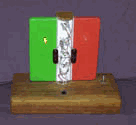| |
Homage to Norbert Wiener
A Decision Machine Suite
Interactive Electronic Sculpture, 1982-1995
The Decision Machine Suite, a series begun in 1982,
pays "homage" to Norbert Wiener (1894-1964), the scientist and humanist
considered to be the father of cybernetics. The choice and arrangement
of materials exhibits a special interest in the fusion of art and
electronics. This series� embodies my on-going interest in celebrating
pioneers like George Boole and Alan Turing who contributed to the
development of� information theory and computing.� These "hard-wired"
works, involved with logical gates (Boolean switching), relate directly
to my interest in the gating logic of general computers and the nature
of information. As with Norbert Wiener, these interests lead us directly
to the human use of machines.
This suite of works, as "homage", provides a playful
cybernetic exercise which touches the very heart of the "human - machine"
dialectic. Each work consists of an electronic circuit that elects only one
of two possible paths at the split moment when the user presses a button.
The circuit "decision" cannot be predetermined by the user so each machine
is, in itself, an excellent randomizer.
The earliest Decision Machine (1982, Yes-No)
displays two lamps labeled "Yes" and "No" respectively. When the user presses
the "enter" key only one lamp "Yes" or "No" responds. Similar to the "flip of
a coin" this machine can handle any "Yes/No" decision. This version and the
1983 "green (yes)" and "red (no)" version are "generic" deciders for ordinary
daily decisions such as whether to listen to this or that music album.
Copyright information
|
|
|
| |

|

|

|
|
Wall Street, Buy or Sell?
1995
Wood, paint, gold leaf, electronic elements
47cm x 30cm
|
|
The Vatican, Right or Wrong?
1994
Wood, paint, gold leaf, electronic elements
42cm x 23cm
|
| |

|

|

|
|
The White House, Yeah or Nay?
1995
Vertical back is original long leaf yellow pine salvaged
from the 1940's White House restoration.
Oak base, plexi-glass, black and white marbles, electronic elements
46cm x 25cm
|
|
To Be or Not To Be?
1995
Wood, copper, plexi-glass, paint, electronic elements
43cm x 18cm
|
| |

|

|

|
|
Generic Decision Machine I, Red or Green?
1983
Wood, paint, plastic, electronic elements
23cm x 15cm
|
|
Generic Decision Machine II, Yes or No?
1982
Wood, electronic elements
21cm x 25cm
|
| |
|
"Reasoning" works wonders for us when we have sufficient time and
information to make an "intelligent" decision. But what of those moments
when reason can't provide the answer and we are forced to choose "this way"
or "that way"? The Decision Machine Suite includes specialized machines
symbolizing several of the most difficult decisions we humans have to make,
decisions we must make at times with the burden of uncertainty. These include:
- VOTING as in The White House, Yeah or Nay?
- INVESTING as in Wall Street, Buy or Sell?
- MORAL DECISIONS as in The Vatican, Right or Wrong?
At times, when rational argument fails, we resort to a "flip of the coin".
These machines provide an electronic flip of the coin for that decision moment
when one is unable to arrive at a decision following reasoned consideration
based on available information.
Norbert Wiener recognized the "fundamental element of chance in the texture
of the universe itself". Computers simulate this "element of chance"
through the use of pseudo-randomizers which are algorithms (mathematical formulas).
Computer simulations generated with pseudo-randomizers are repeatable whereas
the sequence of coin flips is not.
Random events, as in the toss of a coin, defy reason and are not computable -
one cannot determine the next outcome in advance. Such random events from the
microscopic to the macroscopic permeate the texture of our universe. And often,
in our own life, we are forced to make countless decisions for which we could
not give "reasoned" explanations.
The "Decision Machines" provide an electronic trigger that yields
a "random" rather than a "pseudo-random" event. This is appropriate in homage to
Wiener who observed that "The functional part of physics cannot escape
considering uncertainty and the contingency of events." (See The Human Use of
Human Beings: Cybernetics and Society, NY, 1967 Edition, p.15)
Cybernetics is the study of the guidance and control systems we
design for our machines. The successful use of machines is correlative to the
ease and degree of "human" control. Even with our most sophisticated guidance
and control systems our machines intermittently fail - they crash, self destruct
or even turn on us. So we have reason to fear the machine "out of
control".
But here we have a whole suite of machines "out of
control". We enter one bit of information which alters the flow of current
in such a way that we can never know (or control) which path it will elect. Is
this phenomenon fearsome?
This leads us to the ultimate decider but its use is recommended
only for the theater. This is the highest rank Decision Machine, To Be or Not To Be?. It might have served Hamlet
well:
To be or not to be: that is the question.�
Whether
'tis nobler in the mind to suffer�
The slings and arrows of
outrageous fortune,�
Or to take arms against a sea of troubles,�
And by opposing end them? . . .
Technical materials:
The circuit, for each work, is crafted with diodes, transistors,
capacitors, neon lamps, copper wire, solder, and one 'single pole' input switch.
Power supply is household current.
The circuit is mounted symbolically
within the context of a structure designed by the artist to evoke the meanings
associated with each specialized machine. Materials used include: wood, metal,
plastic, paint, and glue. "The Vatican" has gold leafed lamp reflectors. "The
Whitehouse" includes black and white balloting marbles and a piece of wood
salvaged from the 1940's whitehouse renovation.
|
| |
|

